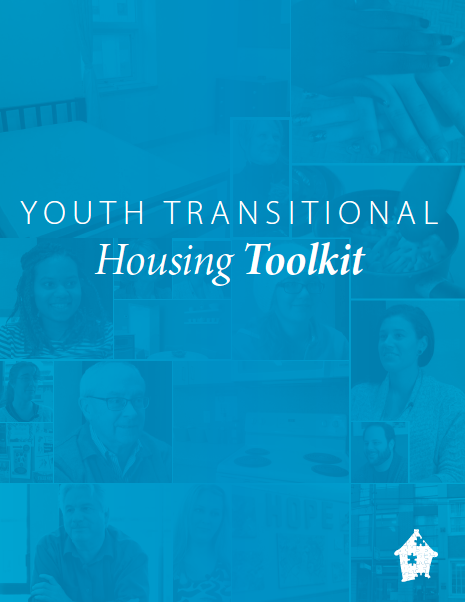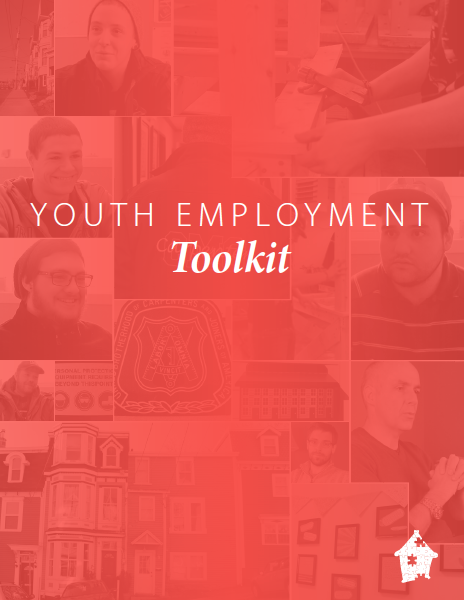The Canadian Observatory on Homelessness and The Home Depot Canada Foundation are thrilled to launch two toolkits aimed at supporting communities working with homeless and at-risk youth. The first looks at transitional housing initiatives for homeless youth using both on- and off-site models of housing. It features the great work being done by Covenant House Toronto and Covenant House Vancouver. The second toolkit examines an innovative youth employment program in St. John’s Newfoundland called Train for Trades. Part of Choices for Youth, this initiative merges green retrofitting, intensive case management and employment training in a successful endeavour.
The Eva’s Initiatives Toolkit guide defines a toolkit as “a curated resource that provides relevant information that can guide users to replicate promising practices and emerging practices. When we use the term curated, we are referring to the process of analysing resources and determining what content is the most relevant and clearest on a specific topic and presenting it in an accessible and meaningful way. A toolkit contains the instructions (program manual) and tools (e.g. logic model/theory of change, workshop designs, policy and procedures, program evaluation) to build the program. Most toolkits are online resources, but may also include modules for offline delivery and use.”
Using Eva’s definition, let’s look at our toolkits. Both toolkits included extensive research and interviews with staff, partners and current and past youth participants in the programs. With both the videos and the written content we have curated the research and resources to provide you with the most important and most relevant material. In fact, we have condensed 17 hours of interviews into about 30-35 short summary videos.
Each toolkit includes both a PDF and online version. The written content is supported by the videos which cover a wide variety of topics and present the information in an engaging format.
Our goal with both of the toolkits is to make replication and adaptation easier. The resources and comprehensive descriptions can allow an agency in Saskatoon to replicate Train for Trades without ever travelling to St. John’s. Similarly, the Vancouver’s transitional housing program could be duplicated in Moncton. When funding permits the lessons learned in face-to-face meetings are invaluable, but the current climate makes this kind of learning more challenging. As such, we feel we have created a tool that allows agencies to gain a full understanding of such promising practices.
 Youth Transitional Housing Toolkit
Youth Transitional Housing Toolkit
As we’ve pointed out in past research on youth homelessness, including our reports: Coming of Age: Reimagining the Response to Youth Homelessness in Canada and A Safe and Decent Place to Live: Towards a Housing First Framework for Youth, there is often a developmental gap in the ability of young people to live independently. As such, transitional housing helps youth gain the life skills and knowledge they need to live on their own with minimal or no support.
Each of the 21 Covenant House locations in North, Central and South America have three core components, one of which is their Rights of Passage (ROP) transitional housing program. Each agency can develop a program to suit the needs and climate of their community and the differences between Toronto and Vancouver’s ROP programs showcase this flexibility.
Both agencies’ transitional housing programs are considered promising practices that follow the Foyer model’s Hub and Spoke component with services provided both at a fixed site (the ROP Program is the Hub) and also through scattered site housing options (these are the Spokes). The agencies have built relationships with private landlords and have also developed unique partnerships with private companies (Hollyburn Properties in Toronto and Vancouver and Daniels Corporation in Toronto) to provide youth with independent living options.
Both ROP programs provide a young person housing in a private room with access to a kitchen, 24-7 staff, meal programs and life skills training. While there are differences between them, what we like about both programs is that they are very youth-driven and youth-focused. Staff and youth work together to develop a case plan that includes employment or education day plans (or support activities for a youth with mental health or addictions issues), learning goals and plans for future independence.
We begin the toolkit with an overview of youth homelessness to provide an overall summary and statistical information. We then move into an overview of Covenant House at the international level as well as in Toronto and Vancouver. Next we look at transitional housing generally and the Foyer’s Hub and Spoke model more specifically.
This is followed by a discussion of Transitional Housing at Covenant House including the Rights of Passage program and the various Scattered Site Transitional Housing Options. This includes a detailed look at the rules and program elements of Rights of Passage.
Finally we look at some of the logistics that would be important to an agency setting up this kind of program including staffing, funding, evaluation, policies and procedures, theories to support the work and Covenant House Toronto’s Mentorship Program.
 Youth Employment Toolkit
Youth Employment Toolkit
Train for Trades (T4T) is just one of many interesting programs at Choices for Youth in St. John’s, Newfoundland. It provides at-risk youth an opportunity to give back and engage in meaningful work. The program also showcases the strength of community partnerships.
Youth receive training from the Carpenters Millwrights College in a variety of safety areas including Fall Protection, First Aid and Ramset gun use. Youth then work in construction doing green retrofitting of basements in houses owned by Newfoundland Labrador Housing Corporation (NLHC). By improving energy efficiency, the youth are contributing to lower heating costs for these social housing tenants.
As youth gain skills, they can also engage in other work. Choices has a new contract with NLHC to completely rebuild the interiors and exteriors of houses including roofs, siding, floors, walls. Additionally, they take on private work that ranges from a garage to a barn, from installing bathrooms for the St. John’s Friendship Centre to building new units of affordable housing for Choices.
More than just an employment program though, T4T is also a support program. It hires high risk youth who face barriers to traditional employment. These youth receive intensive case management supports from support workers. A retired teacher comes to the building site twice a week to assist the youth in obtaining their GED.
Train for Trades is a social enterprise and as such is aimed at becoming completely sustainable. Within a couple of years it will be self-funding and will require no government or corporate grants to support its operations.
We begin this toolkit with an overview of youth homelessness and youth employment, as well as backgrounders on social enterprise, energy poverty and employment insurance.
We then move into an overview and history of Choices for Youth. This is followed by a thorough discussion of the Train for Trades program including history, program and support elements, partners, funding and evaluation.
For more on the toolkits see our upcoming blog posts from Choices for Youth, Covenant House Vancouver, Covenant House Toronto.

